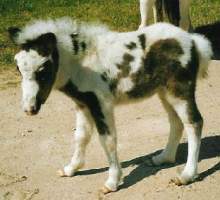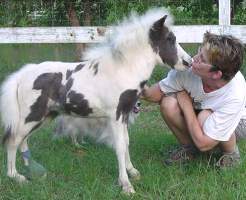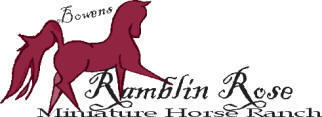
Little Magic Shoes
By Janell Jensen, in
memory of Little Bit
EMail Janell at: janell_jensen@yahoo.com - phone: (832) 217-0058 Click here for Little Magic Shoes Web site
I have found that there is a great need for information on how to help young horses with their many leg problems. Not only dwarf miniature horses, but normal miniatures and big horses as well. I do not claim to be an expert on horses or their legs by any means; however, I have had a lot of experience with horses that have leg problems, and I wanted to write down some of my experiences and include photographs, hoping that it may be of some help to others out there seeking advice on leg problems in horses.
My first experience was with my little dwarf miniature horse, Tessa. I didnít get her until she was nine months old, and she had never had her hooves trimmed until the day we picked her up. They were still way too long, as you can see from this photo.
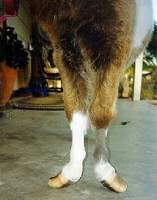 Before surgery |
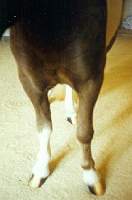 3 months after surgery |
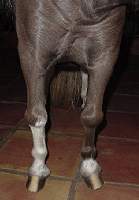 Today, at 7 years of age |
When Tessa was about four years
old, I was asked if I would take another little dwarf, that I named
Little Bit, because he was all of 10 pounds and 13 inches tall, and 12
days old. When I got Little Bit at 12 days old, the owner
had stopped bracing his back legs, but as you can see in this picture,
the tendons were still very weak.
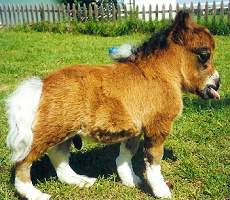
After about a month and a half his
little back legs had gotten strong. His front legs were another story;
his fetlocks were very weak, especially the left one, and without braces
he would walk on the very outside edge of his hooves. My farrier
told me he had seen a horse with a broken fetlock that did not have
asmuch movement in it as Little Bitís left front fetlock!
I know he was
thinking that he should be put to sleep. When Little Bit was almost 3
months old he started getting a pressure sore on his left fetlock, and I
knew something else had to be done for him. I took him to A
& M University and Dr. Honnas trimmed a lot off of his hooves, they
bled, but he said it had to be done. Then he used a heavy mesh and a
product called Technovit to make his hooves larger around at the bottom.
That was all it took to keep his little fetlocks from turning over! That
was the first time I had ever seen him standing without braces. He sent
me home with the mesh and the Technovit and said I could make the
extension myself. Well, I did not want to put the Technovit on the
bottom of his hoof again, so I just made an extension on the outside and
to the back of his hoof with the Technovit, (not only was his fetlock
turning over to the outside, but it was also going down in the back).
The extension worked great, but it had a tendency to pop off if he
stepped on an uneven surface or just wrong.
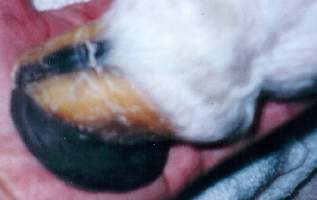 I had bought a little shoe from a lady, but it was made out of a thick
piece of metal(See photo to the right) and I felt that it was too thick
and heavy for Little Bit to wear, especially since he only needed a shoe
on one hoof, and it just was not designed right for his needs.
I had bought a little shoe from a lady, but it was made out of a thick
piece of metal(See photo to the right) and I felt that it was too thick
and heavy for Little Bit to wear, especially since he only needed a shoe
on one hoof, and it just was not designed right for his needs.
That is when I
met a lady on the Internet, who also had a little dwarf with weak
fetlocks. She told me that her husband was a shop teacher and could make
me a little shoe out of a thin, lightweight aluminum, if I would send
him the pattern for it And that they would make a couple for their
little dwarf, too.
Hereís a picture of that little shoe...
~~~~~~~~~~~~~~~~~~~~~~~~~~~~~~~~~~~~~~~~~~~
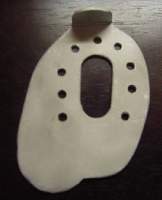 Little Bitís shoe |
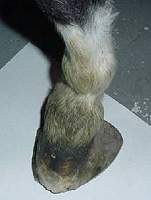 Little Bitís Shoe glued to his hoof |
Little Bit was just a little over 3 years old when he passed away; he was still wearing his little shoe. His fetlock was still a bit weak. He probably would have been able to walk all right without the shoe, but I just did not want to take the chance of losing all the progress that we had made. You cannot expect to be able to correct a horseís legs over night; it may take weeks, months or even years. You just have to be consistent and have lots of patience.
Shortly after my Little Bit passed away, a friend of mine contacted me about a little eight-week old filly she had that was born with weak tendons in all 4 of her legs. This filly was actually walking on her fetlocks; her hooves were not even touching the ground! For the first two weeks of her life she was at the vet clinic because she had a very difficult birth and they taped tongue depressors to the bottom of her hooves. Once my friend got her home, she could tell that was not working any longer, so she took her up to A & M and the vets up there made her the extensions like they had my Little Bit, except the extensions were in the back of the hoof only. They made them pretty thick and it was kind of like she was trying to walk on high heels. Well, they didnít stay on all that long and the filly had learned to throw her left back leg so that the extension was up in the air and then she was back to walking on her fetlock again, which really stretched that tendon even more!
Hereís a picture of the filly when she was about three weeks old, before they had put any extensions on her hooves. In this picture you can see that the tongue depressors had helped her, especially the front legs, at least she was no longer walking on her fetlocks.
The vet trimmed her hooves again and made her some more extensions, she was back to walking on high heels again! She would still throw that left back leg so that the extension was up in the air and her fetlock on the ground, so they figured out that if they taped the extension to her leg a certain way, it kept her walking on the extension. By this time I could see the frustration in my friendís face and I think she was getting exasperated with this filly. The next day my friend called and said, ďIf you want these horses, you can have them!Ē I was there the very next morning with my trailer.
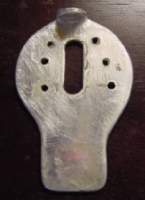 By this time I had designed a little aluminum shoe and my friend was
sending it to me. That next Monday morning I was able to get her
an appointment with Dr. Honnas back up to A & M. He trimmed all four
hooves and stood her up, she had gotten strong on three legs already!
She was up on her hooves, except for the left back leg. They decided
they had better x-ray that leg and make sure all the bones were all
right, and they were! Dr. Honnas told me he thought that if I had the
patience to keep gluing her shoe on every time it came off, that he
didnít think she would have to have surgery on that little leg to put a
plate in, to fuse her fetlock into the right position, but that it may
take four to six months. I told him I was still gluing Little Bitís shoe
on when he died at 3 years old, so six months was no time at all!
He laughed and agreed with me.
By this time I had designed a little aluminum shoe and my friend was
sending it to me. That next Monday morning I was able to get her
an appointment with Dr. Honnas back up to A & M. He trimmed all four
hooves and stood her up, she had gotten strong on three legs already!
She was up on her hooves, except for the left back leg. They decided
they had better x-ray that leg and make sure all the bones were all
right, and they were! Dr. Honnas told me he thought that if I had the
patience to keep gluing her shoe on every time it came off, that he
didnít think she would have to have surgery on that little leg to put a
plate in, to fuse her fetlock into the right position, but that it may
take four to six months. I told him I was still gluing Little Bitís shoe
on when he died at 3 years old, so six months was no time at all!
He laughed and agreed with me.
A few days later Fairyís bright, shinny aluminum shoe arrived in the mail About four weeks later I took her back up to A & M and Dr. Honnas trimmed all of her little hooves again. When he stood her up this time, she was walking on all four hooves!! I think he was really surprised at how quickly she had gotten strong. Four weeks is a lot less time than four to six months! I am very proud of Fairyís progress! She is such a little sweetheart. Thank you, Maxine, for giving her to me!
The name of the glue I like to use is called: Equithane SuperFast made by Vettecc. Their website is: www.vettec.com They have been very helpful to me and will be glad to tell you where the nearest dealer to you is located. They will also send a video that shows you how to use the SuperFast and the different uses for it. That reminds me, after awhile Little Bitís right front hoof started getting under-run heels, so I would use the SuperFast to build his heels up and get him back at the right angle. It can also be used to make toe extensions for foals with contracted tendons; it keeps them from walking on the tips of their toes.
Hereís a picture of Fairy with the extensions on made out of Technovit and mesh.
Notice how they had to tape the one extension to her leg.
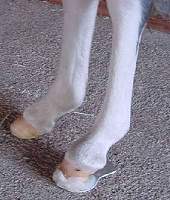 Fairy with shoe glued on |
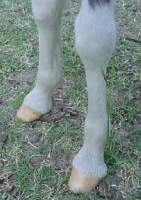 Fairyís front legs |
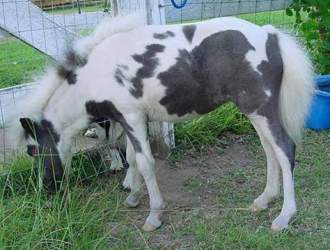
Fairy barefoot & fancy-free!
Here is another great example of what extensions, patience and consistency can do for a little horse...
Chester was born with very weak fetlocks and weak tendons in all of his legs, when he was a week old his owner made some braces out of dog splints with Velcro, which he learned how to pull off! And when he was about 3 or 4 weeks old her farrier trimmed his hooves and made Chester some extensions on his hooves out of solid aluminum plates and glued then on with a product called Equilox, which were left on for about eight weeks. When they were taken off, Chesterís legs were much stronger, and he walked almost perfectly. He was then able to run and play with his little buddies!
I think the farrier had the right idea, but I do not think it is a good idea to seal off the entire bottom of a horseís hoof. I am very surprised that little Chester did not get an infection in his hooves, like my Little Bit & Fairy did! (I found out later, that he did develop Thrush in his hooves) If you notice, the little ďMagic ShoesĒ have what I call a frog hole; it lets air get to the bottom of the horseís hoof, which I think is very important. You have to keep it cleaned out, just as you would normally with a hoof that does not have a shoe glued onto it. The holes that are drilled into the shoe act almost as if they were horseshoe nails; they help the glue hold the shoe onto the hoof.
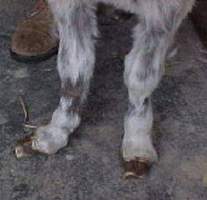 Chester "BEFORE" Magic Shoes |
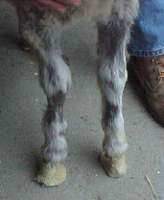 Chester "AFTER" Magic Shoes |
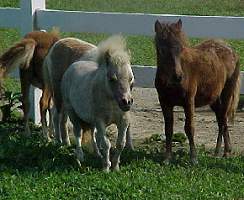
Chester can now play with his buddies!
Thank you for reading, if you would like to know more please Click here for Little Magic Shoes Web site
